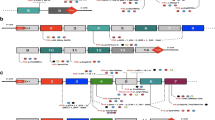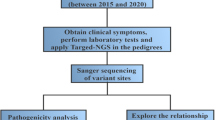Abstract
Maple Syrup Urine Disease (MSUD) is a rare autosomal recessive disorder of branched-chain amino acid (BCAA) metabolism. The disease is mainly caused by mutations either in the BCKDHA, BCKDHB, DBT or DLD genes encoding components of the E1α, E1β, E2 and E3 subunits of branched-chain α-keto acid dehydrogenase complex (BCKDC), respectively. BCKDC is a mitochondrial enzyme which is responsible for the normal breakdown of BCAA. The rate of consanguineous marriage in Iran is 38.6 %, so the prevalence of autosomal recessive disorders is higher in comparison to other countries. Consanguinity increases the chance of the presence of pathogenic mutations in a homoallelic state. This phenomenon has made homozygosity mapping a powerful tool for finding the probable causative gene in heterogeneous disorders like IEM (Inborn Errors of Metabolism). In this study, two sets of multiplex polymorphic STR (Short Tandem Repeat) markers linked to the above-mentioned genes were selected to identify the probable pathogenic gene in the studied families. The families who showed a homozygous haplotype for the STR markers of the BCKDHB gene were subsequently sequenced. Four novel mutations including c.633 + 1G > A, c.988G > A, c.833_834insCAC, and a homozygous deletion of whole exon 3 c. (274 + 1_275–1) _(343 + 1_344–1), as well as one recently reported (c. 508G > T) mutation have been identified. Interestingly, three families shared a common haplotype structure along with the c. 508G > T mutation. Also, four other families revealed another similar haplotype with c.988G > A mutation. Founder effect can be a suggestive mechanism for the disease. Additionally, structural models of MSUD mutations have been performed to predict the pathogenesis of the newly identified variants.






Similar content being viewed by others
References
Adzhubei IA et al. (2010) A method and server for predicting damaging missense mutations. Nat Methods 7:248–249
Ævarsson A, Chuang JL, Wynn RM, Turley S, Chuang DT, Hol WG (2000) Crystal structure of human branched-chain α-ketoacid dehydrogenase and the molecular basis of multienzyme complex deficiency in maple syrup urine disease. Structure 8:277–291
Benson G (1999) Tandem repeats finder: a program to analyze DNA sequences. Nucleic Acids Res 27:573
Chuang DT SV (2001) Maple syrup urine disease (branchedchain ketoaciduria). In: Scriver CR Beaudet AL SW, Valle D, (eds) CB, Kinzler KW, Vogelstein B (assoc eds). (eds) The Metabolic and Molecular Basis of Inerited Disease. Mc Graw-Hil, New York, pp 1971–2006
Den Dunnen JT, Antonarakis SE (2000) Mutation nomenclature extensions and suggestions to describe complex mutations: a discussion. Hum Mutat 15:7–12
Desmet F-O, Hamroun D, Lalande M, Collod-Béroud G, Claustres M, Béroud C (2009) Human Splicing Finder: an online bioinformatics tool to predict splicing signals. Nucleic Acids Res 37:e67–e67
Eswar N et al. (2006) Comparative protein structure modeling using Modeller. Current Protocols in Bioinformatics: 5.6. 1–5.6. 30
Foroozani H et al. (2015) Molecular Characterization of QDPR Gene in Iranian Families with BH4 Deficiency: Reporting Novel and Recurrent Mutations
Harris RA, Joshi M, Jeoung NH (2004) Mechanisms responsible for regulation of branched-chain amino acid catabolism. Biochem Biophys Res Commun 313:391–396
Humphrey W, Dalke A, Schulten K (1996) VMD: visual molecular dynamics. J Mol Graph 14:33–38
Korein J, Sansaricq C, Kalmijn M, Honig J, Lange B (1994) Maple syrup urine disease: clinical, EEG, And plasma amino acid correlations with a theoretical mechanism of acute neurotoxicity. Int J Neurosci 79:21–45
Kumar P, Henikoff S, Ng PC (2009) Predicting the effects of coding non-synonymous variants on protein function using the SIFT algorithm. Nat Protoc 4:1073–1081
Legendre M, Pochet N, Pak T, Verstrepen KJ (2007) Sequence-based estimation of minisatellite and microsatellite repeat variability. Genome Res 17:1787–1796
Lu G et al. (2009) Protein phosphatase 2Cm is a critical regulator of branched-chain amino acid catabolism in mice and cultured cells. J Clin Invest 119:1678–1687 doi:10.1172/jci38151
Miller SA, Dykes DD, Polesky HF (1988) A simple salting out procedure for extracting DNA from human nucleated cells. Nucleic Acids Res 16:1215
Miryounesi M, Ghafouri-Fard S, Goodarzi H, Fardaei M (2015) A new missense mutation in the BCKDHB gene causes the classic form of maple syrup urine disease (MSUD). Journal of pediatric endocrinology & Metabolism: JPEM 28:673–675 doi:10.1515/jpem-2014-0341
Phillips JC et al. (2005) Scalable molecular dynamics with NAMD. J Comput Chem 26:1781–1802
Reed LJ, Damuni Z, Merryfield ML (1985) Regulation of mammalian pyruvate and branched-chain alpha-keto acid dehydrogenase complexes by phosphorylation-dephosphorylation. Curr Top Cell Regul 27:41–49
Roy A, Kucukural A, Zhang Y (2010) I-TASSER: a unified platform for automated protein structure and function prediction. Nat Protoc 5:725–738
Saadat M, Ansari-Lari M, Farhud DD (2004) Consanguineous marriage in Iran. Ann Hum Biol 31:263–269 doi:10.1080/03014460310001652211
Shaw V (2014) Clinical paediatric dietetics. John Wiley & Sons, Blackwell Science, London
Yang J, Zhang Y (2015) I-TASSER server: new development for protein structure and function predictions. Nucleic Acids Res 43:W174–W181
Yang J, Yan R, Roy A, Xu D, Poisson J, Zhang Y (2015) The I-TASSER Suite: protein structure and function prediction. Nat Methods 12:7–8
Yoshino M et al. (1999) Management of acute metabolic decompensation in maple syrup urine disease: A multi-center study. Pediatr Int 41:132–137
Zhang Y (2008) I-TASSER server for protein 3D structure prediction. BMC Bioinform 9:40
Acknowledgments
We thank the patients and their families for their cooperation in this study.
Author information
Authors and Affiliations
Corresponding author
Ethics declarations
Conflict of interest
The authors declare no conflict of interest.
Rights and permissions
About this article
Cite this article
Abiri, M., Karamzadeh, R., Mojbafan, M. et al. In silico analysis of novel mutations in maple syrup urine disease patients from Iran. Metab Brain Dis 32, 105–113 (2017). https://doi.org/10.1007/s11011-016-9867-1
Received:
Accepted:
Published:
Issue Date:
DOI: https://doi.org/10.1007/s11011-016-9867-1




